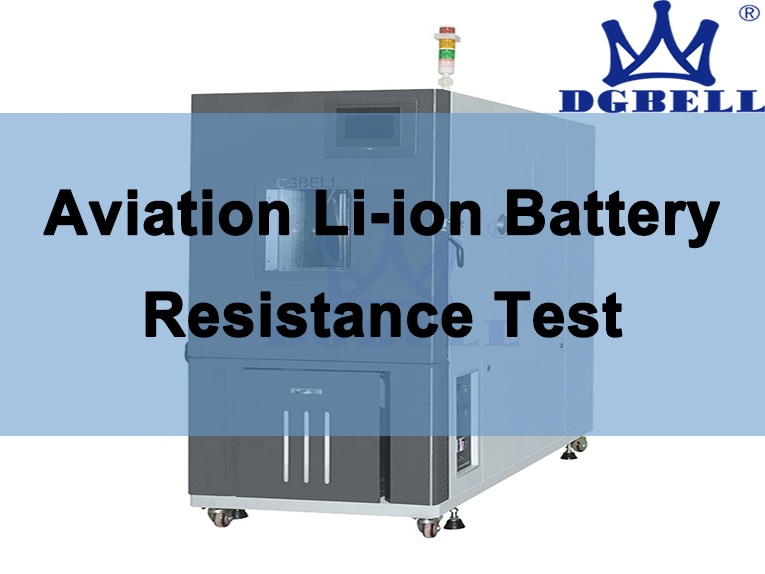
#Industry News
Aviation Li-ion Battery Resistance Test
Aviation Li-ion Battery Resistance Test
As an important component of spacecraft, power cobalt oxide lithium-ion batteries provide energy for most electronic systems. The performance of lithium-ion batteries directly affects the safety, smoothness, and economy of spacecraft operation. The requirements for battery performance under aviation conditions can be roughly divided into three points: good temperature stability, high specific energy, and long cycle life. Compared with other traditional lithium batteries, cobalt ion batteries have multiple advantages such as reliable operation in low-temperature environments, stable voltage output, high specific energy, and multiple cycles, meeting the requirements for extreme conditions such as aerospace.
The size of the internal resistance of a battery directly determines its capacity, and at the same time, the internal resistance of a battery also determines its working efficiency. In the actual use of batteries, the internal resistance of lithium-ion batteries is constantly changing under different environmental temperatures and SOC conditions. In practical research, combining the variation curve of battery internal resistance can more accurately estimate the actual SOC of the battery.
Through experimental testing, it was found that as the temperature decreases, the ohmic resistance and polarization resistance of the iron phosphate battery gradually increase during charging and discharging. Temperature is an important factor affecting the internal resistance of batteries. Environmental temperature has a significant impact on the capacity of lithium iron phosphate batteries. At low temperatures, the capacity rapidly decays, while at high temperatures, the capacity rapidly increases. However, the rate of change is slower than at low temperatures.
Considering the safety of aerospace batteries in use and the lack of research on the internal resistance characteristics of cobalt oxide lithium-ion batteries by scholars, temperature testing of aerospace lithium-ion batteries is necessary. This article uses 0-50 ℃ to conduct internal resistance tests on cobalt oxide lithium-ion batteries, and uses HPPC (Hybrid Pulse Power Characterization) method to test 45 Ah ICP 45 batteries under different environmental temperatures and SOC states. The changes in internal resistance of cobalt oxide lithium-ion batteries under different environmental temperatures and SOC are studied in detail.
1 Test
1.1 Test subjects and equipment
The experimental battery used was an ICP 45 cobalt oxide lithium-ion battery. The rated capacity of the battery is 45 Ah, and the positive electrode material is lithium cobalt oxide. Battery charging and discharging equipment. The constant temperature box adopts the DGBELL temperature humidity test chamber.
1.2 HPPC Test and internal resistance calculation method
There are many methods for testing the internal resistance of lithium batteries, including the volt ampere characteristic curve method, open circuit voltage method, mixed pulse power characteristic method (HPPC), and AC impedance method. This article uses the HPPC method to test the resistance of lithium batteries, which is recorded in the Freedom CAR project “Power Assisted Hybrid Vehicle Power Battery Test Manual” in the United States. Compared with other internal resistance detection methods, this method has significant advantages in detection accuracy and efficiency. The HPPC method can be used to measure the polarization resistance and Ohmic resistance of batteries in various states.
Firstly, a discharge pulse current is applied at both ends of the battery, and the voltage drops to U 1 at the moment of pulse loading, then the downward trend slows down. After the current continues for 10 seconds, the pulse loading is cancelled at time t 2, and the voltage instantly recovers to U 3. After waiting for 40 seconds, the voltage stabilizes at U 4. The step process from U 2 to U 3 originates from the internal Ohmic resistance of the battery, while the gradual process from U 3 to U 4 is a voltage decay on both sides of the polarization resistance, and the voltage tends to stabilize at U 4. HPPC calculates the ohmic resistance and polarization resistance of a battery by testing the voltage changes during the initial stage of current loading. By measuring the voltage in the discharge experiment, calculate the internal resistance of charging and discharging under different states of charge.
1.3 Test Steps
Step 1: Activate the lithium cobalt oxide battery through cyclic charging and discharging experiments. The upper limit voltage of ICP 45 is 4.15 V, and the offline voltage is 3.0 V. Cycle charging and discharging three times, charging at a rate of 0.2 C and discharging at a rate of 0.1 C. After each charge or discharge, let it stand for 12 hours;
Step 2: Start discharging the 100% SOC ICP 45 battery at a rate of 0.5 C and record the discharge time. After discharging for 12 minutes (the remaining 90% SOC of the battery is left to stand for 1 hour), start mixed pulse power characteristic testing and record the open circuit voltage, OCV discharge current, and time;
Step 3: Repeat the steps of the second step, record the open circuit voltage and discharge current of the battery at 90%, 80%, 70%, 60%, 50%, 40%, 30%, 20%, 10%, and 0% at different SOC, and calculate the ohmic resistance and polarization resistance; Step 4: Turn off the electronic load and charging power, disconnect the relay, and output the data to an Excel spreadsheet.
2 Test Results and Analysis
2.1 Analysis of Ohmic Internal Resistance Characteristics
The internal resistance of lithium cobalt oxide batteries is composed of Ohmic Internal Resistance and Polarization Internal Resistance. Through the analysis of experimental data, it can be concluded that as the temperature decreases, the Ohmic internal resistance continuously increases. The main reason is that the ohmic internal resistance of cobalt oxide lithium-ion batteries is mainly composed of electrolyte, electrical connectors, and positive and negative electrodes. When the ambient temperature is low, the solubility of lithium ions in the electrolyte inside the cobalt oxide lithium-ion battery rapidly decreases, causing lithium ions to precipitate in the electrolyte, reducing the concentration of lithium ions per unit volume, slowing down the diffusion rate of lithium ions in the electrolyte, and increasing the ohmic internal resistance of the battery.
We compared the variation characteristics of Ohmic internal resistance with SOC at 0, 10, 20, 30 ℃, and 50 ℃, and found that the SOC of cobalt oxide lithium-ion batteries varies slowly within the operating range of (20%, 100%) at ambient temperatures above 20 ℃. For example, under the condition of 30 ℃, the Ohmic internal resistance of cobalt oxide lithium-ion batteries remains stable at 0.7 m Ω during normal operation. Therefore, the ohmic internal resistance of the battery within this temperature range at SOC (20%, 100%) can be considered as a constant value.
The Ohmic internal resistance is extremely sensitive to changes in environmental temperature, and when the temperature is less than 10 ℃, the Ohmic internal resistance of the battery changes significantly with the battery SOC. When the battery SOC is at a high state, the ion movement inside the battery is more active, which compensates for the decrease in electrolyte activity and has a smaller impact on the Ohmic resistance. But as the SOC of the battery decreases, the internal ion energy of the battery also decreases, leading to a rapid increase in Ohmic resistance. Through the two curves of 10 ℃ and 0 ℃, it can be seen that as the temperature decreases, the Ohmic internal resistance increases at a faster rate with the increase of battery SOC.
2.2 Analysis of polarization internal resistance and total internal resistance characteristics
We can conclude that the polarization resistance of batteries is mainly affected by temperature, which is related to the slowing down of concentration diffusion rate at low temperatures. At 0 ℃, the polarization resistance of the battery is almost three times that of 50 ℃ under the same conditions. At the same temperature, the polarization resistance of the battery changes very little, especially when the SOC is within the range of (20%, 90%), and the polarization resistance of the battery can be considered as a constant value.
The polarization resistance of cobalt oxide lithium-ion batteries increases with the decrease of battery SOC within the range of (0%, 20%). The polarization internal resistance of cobalt oxide lithium-ion batteries increases with the decrease of temperature. This is because the activity of the dissociated lithium downstream of the cobalt oxide lithium-ion battery decreases at low temperatures, making it difficult to deintercalate at the negative electrode, resulting in an increase in the polarization internal resistance of the battery. When the temperature is high, the energy of lithium ions in the negative electrode of the battery is high, which accelerates the diffusion rate of ions
At SOC between 0% and 20%, the ohmic resistance and polarization resistance of lithium ion batteries gradually increase with the decrease of SOC. However, the increase in Ohmic internal resistance as SOC decreases is significantly greater than that of polarization internal resistance, indicating that Ohmic internal resistance is more sensitive to battery SOC. Under the same SOC state, both polarization resistance and Ohmic resistance gradually increase with the decrease of temperature. Through data analysis, it is found that the amplitude of polarization resistance increasing with the decrease of temperature is significantly greater than that of Ohmic resistance, indicating that polarization resistance is more sensitive to low temperature.
When the temperature is low, the polarization internal resistance of the battery is relatively high, but it only accounts for one fourth of the total internal resistance of the battery, and its impact on the capacity and working efficiency of the battery is relatively limited. Although the polarization resistance of the battery increases by more than twice at low temperatures compared to room temperature, compared to other resistors, especially lithium iron phosphate or lead-acid batteries, the polarization resistance of cobalt oxide lithium iron batteries still has good temperature stability.
By analyzing the relationship between battery internal resistance and SOC, it is concluded that in the range of SOC (0%, 20%), the total internal resistance of the battery will increase with the decrease of battery SOC. High internal resistance will lead to an increase in battery heat generation and shorten the battery’s service life. Improper use will cause the battery to discharge excessively and become unusable. Therefore, in order to prolong the service life of the battery, it is advisable to keep the battery operating within the range of SOC 30% to 100%.
By analyzing the relationship between temperature and battery internal resistance, it is concluded that the battery internal resistance will increase with the decrease of temperature, and an increase in battery internal resistance will lead to a decrease in battery capacity. In order to ensure the efficiency of the battery, it is advisable to keep the battery operating above 10 ℃ as much as possible. When the temperature is below 10 ℃, in order to avoid the impact of low temperature environment on battery efficiency, it is necessary to heat the battery pack before starting the battery. Because the battery generates heat during operation, there is no need to heat the battery during operation.
3 Conclusion
This article conducts experiments on aviation lithium cobalt oxide batteries, analyzes the changes in the Ohmic and Polarizing Internal Resistance of the batteries at different SOC and temperatures, and summarizes the reasons for the corresponding changes. The polarization resistance and ohmic resistance of lithium ion batteries with drilling acid will increase with the decrease of temperature. The polarization resistance is more sensitive to temperature, while the ohmic resistance will be affected by temperature and SOC. For the characteristic that the polarization resistance of lithium cobalt oxide batteries increases with the decrease of temperature, it is necessary to heat the battery pack at low temperatures to improve battery capacity and efficiency.







